Ellipse (Lecture-01)
1. Definition of an Ellipse
An ellipse is the set of all points in a plane, the sum of whose distances from two fixed points in the plane is a constant. Fixed points are called focus.
$\mathrm{PF} _{1}+\mathrm{PF} _{2}=$ constant
2. Standard equation of an ellipse.
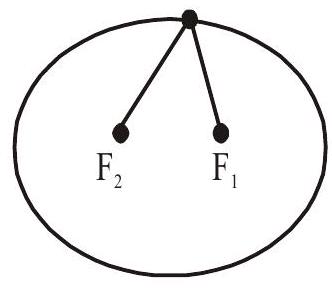
$\dfrac{\mathrm{x}^{2}}{\mathrm{a}^{2}}+\dfrac{\mathrm{y}^{2}}{\mathrm{~b}^{2}}=1$ with $\mathrm{a}>\mathrm{b}$.
Where $\mathrm{b}^{2}=\mathrm{a}^{2}\left(1-\mathrm{e}^{2}\right)$
(i) The line containing the two fixed points (foci) is called focal axis (majoraxis) and points of intersection of the curve with focal axis are called the vertices of the ellipse ie. $A(a, 0)$
$\text { and } \mathrm{A}^{\prime}(-\mathrm{a}, 0)$
The distance between $\mathrm{F} _{1}$ and $\mathrm{F} _{2}$ is called the focal length. $\mathrm{F} _{1} \mathrm{~F} _{2}=2 \mathrm{ae}$.
The distance between the vertices is $\mathrm{A}^{\prime}$ $=2 \mathrm{a}$ is called major axis.
The distance $\mathrm{BB}^{1}=2 \mathrm{~b}$ is called minor axis
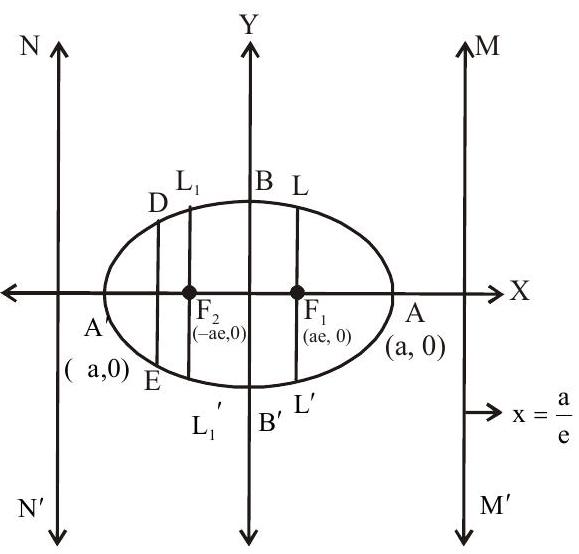
(ii) Point of intersection of the major and minor axis is called the centre of the ellipse. Any chord of the ellipse passing through it gets bisected by it and is called diameter.
(iii) Any chord through focus is called a focal chord and any chord perpendicular to the focal axis is called double ordinate $\mathbf{D E}$.
(iv) A particular double ordinate through focus and perpendicular to focal axis is called its latus rectum $\left(L L^{\prime}\right)$. Length of latus rectum $=\dfrac{2 b^{2}}{a}$
(v) $\mathrm{MM}^{\prime}$ and $\mathrm{NN}^{\prime}$ are two directrices of the ellipse and their equations are $\mathrm{x}=\dfrac{\mathrm{a}}{\mathrm{e}}$ and $x=-\dfrac{a}{e}$ respectively
(vi) A chord of the ellipse passing through its focus is called a focal chord.
(vii) An ellipse is the locus of point which moves in a plane such that the ratio of its distance from a fixed point (focus) to the fixed line (directrix). This ratio is called eccentricity and is denoted by e. For an ellipse e $<1$.
(viii) The equation to the ellipse whose focus is (h.k) and directrix is $\ell \mathrm{x}+\mathrm{my}+\mathrm{n}=0$ and whose
centricity $\mathrm{e}<1$, is $(\mathrm{x}-\mathrm{h})^{2}+(\mathrm{y}-\mathrm{k})^{2}=\mathrm{e}^{2}\left(\dfrac{\ell \mathrm{x}+\mathrm{my}+\mathrm{n}}{\sqrt{\ell^{2}+\mathrm{m}^{2}}}\right)^{2}$.
(ix) Special form If the centre of the ellipse is at point ( $\mathrm{k}, \mathrm{k})$ and the directions of the axis are parallel to the co-ordinate axes, then its equation is $\dfrac{(x-h)^{2}}{a^{2}}+\dfrac{(y-k)^{2}}{b^{2}}=1$
If we shift the origin at $(\mathrm{h}, \mathrm{k})$ rotating totaling co-ordinate axes then equation of the ellipse with respect to new origin becomes $\dfrac{\mathrm{X}^{2}}{\mathrm{a}^{2}}+\dfrac{\mathrm{Y}^{2}}{\mathrm{~b}^{2}}=1$
Auxiliary Circle
The circle described on the major axis of an ellipse as diameter is called an auxiliary circle of the ellipse
If $\dfrac{x^{2}}{a^{2}}+\dfrac{y^{2}}{b^{2}}=1$ is an ellipse then its auxiliary circle is $x^{2}+y^{2}=a^{2}$
Eccentric angle of a point
Let $\mathrm{P}$ be any point on the ellipse $\dfrac{\mathrm{x}^{2}}{\mathrm{a}^{2}}+\dfrac{\mathrm{y}^{2}}{\mathrm{~b}^{2}}=1$
Draw PM perpendicular to major axis from $\mathrm{P}$ and produce MP to meet the auxiliary circle at Q. Join CQ.
$\angle \mathrm{QCA}=\theta$ is called eccentric angle of point $\mathrm{P}$
Note that the angle ACP is not eccentric angle. i.e. eccentric angle of $\mathrm{P}$ on an ellipse is the angle which the radius through the corresponding point on, the auxiliary circle makes with the major axis
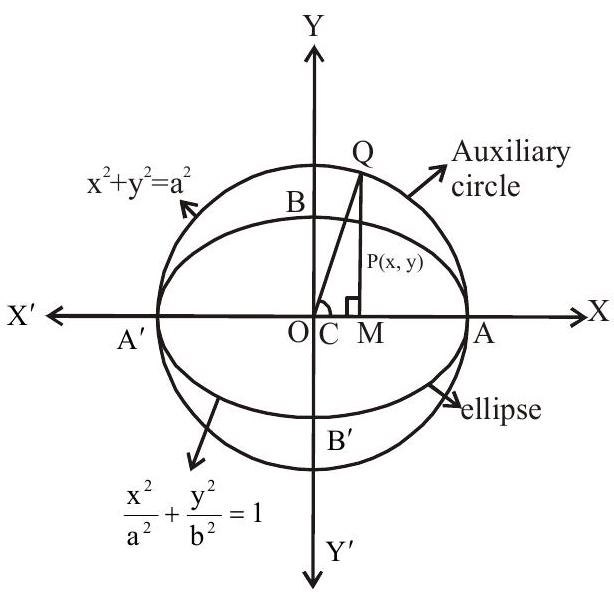
$\therefore \mathrm{Q}(\operatorname{acos} \theta, \operatorname{asin} \theta)$
$\therefore \mathrm{x}$-coordinate of $\mathrm{P}$ is acos $\theta$
$\dfrac{\mathrm{a}^{2} \cos ^{2} \theta}{\mathrm{a}^{2}}+\dfrac{\mathrm{y}^{2}}{\mathrm{~b}^{2}}=1$
$\dfrac{\mathrm{y}^{2}}{\mathrm{~b}^{2}}=1-\cos ^{2} \theta$
$\mathrm{y}^{2} \quad=\mathrm{b}^{2} \sin ^{2} \theta$
$\mathrm{y} \quad =\mathrm{b} \sin \theta$
$\therefore$ Coordinate of $\mathrm{P}$ is $(\mathrm{a} \cos \theta, \mathrm{b} \sin \theta)$
i.e. $x=\operatorname{acos} \theta$ and $y=b \sin \theta$ is the parameter equations of the ellipse.
$(a \cos \theta, b \sin \theta)$ is also called the point ’ $\theta$ '
Equation of the chord
Let $P(a \cos \theta, b \sin \theta)$ and $Q(a \cos \phi, b \sin \phi)$ be any two points of the ellipse $\dfrac{x^{2}}{a^{2}}+\dfrac{y^{2}}{b^{2}}=1$ then the equation of the chord joining these two points is
$\mathrm{y}-\mathrm{b} \sin \theta=\dfrac{\mathrm{b} \sin \phi-\mathrm{b} \sin \theta}{\mathrm{a} \cos \phi-\mathrm{a} \cos \theta}(\mathrm{x}-\mathrm{a} \cos \theta)$
Simplifying the equation we get
$\dfrac{\mathrm{x}}{\mathrm{a}} \cos \left(\dfrac{\theta+\phi}{2}\right)+\dfrac{\mathrm{y}}{\mathrm{b}} \sin \left(\dfrac{\theta+\phi}{2}\right)=\cos \dfrac{\theta-\phi}{2}$
$\theta$ & $\phi$ are eccentric angle of points $P$ and $Q$ of ellipse
Position of a point $(h, k)$ with respect to an ellipse
Let ellipse be $\dfrac{\mathrm{x}^{2}}{\mathrm{a}^{2}}+\dfrac{\mathrm{y}^{2}}{\mathrm{~b}^{2}}=1$
Now P will lie outside, on or inside the ellipse $\dfrac{\mathrm{x}^{2}}{\mathrm{a}^{2}}+\dfrac{\mathrm{y}^{2}}{\mathrm{~b}^{2}}=1$ according as
$\dfrac{\mathrm{h}^{2}}{\mathrm{a}^{2}}+\dfrac{\mathrm{k}^{2}}{\mathrm{~b}^{2}}-1>,=,<0$
Intersection of a line and an ellipse
Line $\mathrm{y}=\mathrm{mn}+\mathrm{c}$______________(1) and ellipse $\dfrac{x^{2}}{a^{2}}+\dfrac{y^{2}}{b^{2}}=1$________________(2)
Solving equations (1) & (2) we get
$\left(a^{2} m^{2}+b^{2}\right) x^{2}+2 a^{2} \mid c m x+a^{2}\left(c^{2}-b^{2}\right)=0$
If $\mathrm{D}>0$ then $\mathrm{y}=\mathrm{mx}+\mathrm{c}$ is a secant
$\mathrm{D}=0$ then $\mathrm{y}=\mathrm{mx}+\mathrm{c}$ is a tangent
$\mathrm{D}<0 \mathrm{y}=\mathrm{mx}+\mathrm{c}$ does not meet ellipse
Point form
Equation of tangent to the ellipse at point $\left(x _{1}, y _{1}\right)$
Let the equation of ellipse be $\dfrac{x^{2}}{a^{2}}+\dfrac{y^{2}}{b^{2}}=1$
Then equation of tangent in point form is $\dfrac{\mathrm{xx} _{1}}{\mathrm{a}^{2}}+\dfrac{\mathrm{yy} _{1}}{\mathrm{~b}^{2}}=1$
Parametric form
Equation of tangent at point $(a \cos \theta, b \sin \theta)$ to the ellipse is $\dfrac{x \cos \theta}{a}+\dfrac{y \sin \theta}{b}=1$
Slope form
$y=m x \pm \sqrt{a^{2} m^{2}+b^{2}}$ is a tangent to an ellipse $\dfrac{x^{2}}{a^{2}}+\dfrac{y^{2}}{b^{2}}=1$ and point of contact is $\left( \pm \dfrac{\mathrm{a}^{2} \mathrm{~m}}{\sqrt{\mathrm{a}^{2} \mathrm{~m}^{2}+\mathrm{b}^{2}}}, \overline{+} \dfrac{\mathrm{b}^{2}}{\sqrt{\mathrm{a}^{2} \mathrm{~m}^{2}+\mathrm{b}^{2}}}\right)$
Number of tangents through a given point $P(h, k)$
$y=m x+\sqrt{a^{2} m^{2}+b^{2}}$ is any tangent to the ellipse $\dfrac{x^{2}}{a^{2}}+\dfrac{y^{2}}{b^{2}}=1$
If it passes through $\mathrm{P}(\mathrm{h}, \mathrm{k})$ then
$\mathrm{k}=\mathrm{mh}+\sqrt{\mathrm{a}^{2} \mathrm{~m}^{2}+\mathrm{b}^{2}}$
$\mathrm{k}-\mathrm{mh}=\sqrt{\mathrm{a}^{2} \mathrm{~m}^{2}+\mathrm{b}^{2}}$
$(\mathrm{k}-\mathrm{mh})^{2}=\mathrm{a}^{2} \mathrm{~m}^{2}+\mathrm{b}^{2}$
$\mathrm{m}^{2}\left(\mathrm{~h}^{2}-\mathrm{a}^{2}\right)-2 \mathrm{hkm}+\left(\mathrm{k}^{2}-\mathrm{b}^{2}\right)=0$
It is a quadratic in $m$ and will give two values of $m$ hence there are two tangents.
Equations of Normals in different forms
(i) Point form
Let equation of ellipse be $\dfrac{x^{2}}{a^{2}}+\dfrac{y^{2}}{b^{2}}=1$
Equation of normal is $\dfrac{a^{2} x}{x _{1}}-\dfrac{b^{2} y}{y _{1}}=a^{2}-b^{2}$
(ii) Parametric form
Let equation of ellipse be $\dfrac{x^{2}}{a^{2}}+\dfrac{y^{2}}{b^{2}}=1$
Equation of normal is axsec $\phi-\operatorname{bycosec} \phi=\mathrm{a}^{2}-\mathrm{b}^{2}$
$(a \cos \phi, b \sin \phi)$ is parametric coordinates of $\mathrm{P}\left(\mathrm{x} _{1}, \mathrm{y} _{1}\right), \mathrm{P}(\operatorname{acos} \phi, \mathrm{bsin} \phi)$
(iii) Slope form
For an ellipse $\dfrac{\mathrm{x}^{2}}{\mathrm{a}^{2}}+\dfrac{\mathrm{y}^{2}}{\mathrm{~b}^{2}}=1$
Equation of normal in terms of slope $(\mathrm{m})$ is
$\mathrm{y}=\mathrm{mx} \pm \dfrac{\mathrm{m}\left(\mathrm{a}^{2}-\mathrm{b}^{2}\right)}{\sqrt{\mathrm{a}^{2}+\mathrm{b}^{2} \mathrm{~m}^{2}}}$
Condition of normality when $y=m x+c$ is the normal of $\dfrac{x^{2}}{a^{2}}+\dfrac{y^{2}}{b^{2}}=1$ is
$c^{2}=\dfrac{m^{2}\left(a^{2}-b^{2}\right)^{2}}{a^{2}+b^{2} m^{2}}$
1. The eccentric angles of the extremities of latus rectum to the ellipse $\dfrac{x^{2}}{a^{2}}+\dfrac{y^{2}}{b^{2}}=1$ are given by
(a) $\tan ^{-1}$
(b) $\tan ^{-1}\left( \pm \dfrac{\mathrm{be}}{\mathrm{a}}\right)$
(c) $\tan ^{-1}\left( \pm \dfrac{\mathrm{b}}{\mathrm{ae}}\right)$
(d) $\tan ^{-1}\left( \pm \dfrac{\mathrm{a}}{\mathrm{be}}\right)$
Show Answer
Solution:
$\begin{aligned} & \text { Let } L(a \cos \theta, b \sin \theta)=\left( \pm a e, \pm \dfrac{b^{2}}{a}\right) \\ & \operatorname{acos} \theta= \pm a e b \sin \theta= \pm \dfrac{b^{2}}{a} \\ & \tan \theta= \pm \dfrac{b}{a e} \\ & \theta=\tan ^{-1}\left(\dfrac{b}{a e}\right) \end{aligned}$
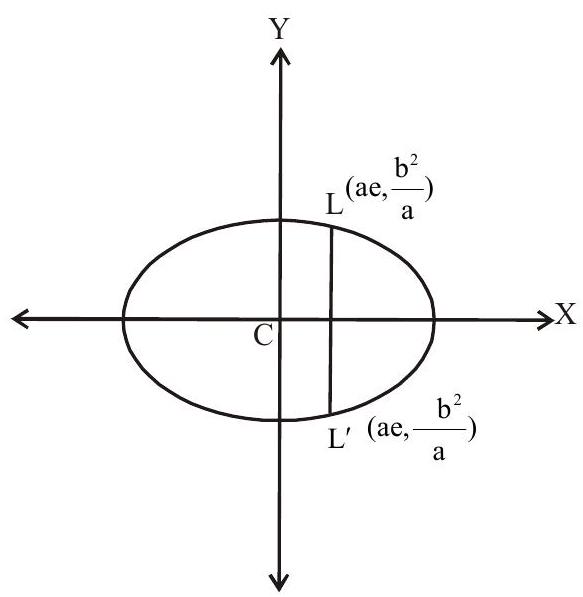
$\therefore$ correct option is c
2. The foci of the ellipse $25(x+1)^{2}+9(y+2)^{2}=225$, are at
(a) $(-1,2)$ & $(-1,-6)$
(b) $(-2,1)$ and $(-2,6)$
(c) $(-1,-2)$ & $(-2,-1)$
(d) $(-1,-2)$ and $(-1,-6)$
Show Answer
Solution:
Here equation of ellipse is
$25(x+1)^{2}+9(y+2)^{2}=225$
or $\quad \dfrac{(\mathrm{x}+1)^{2}}{9}+\dfrac{(\mathrm{y}+2)^{2}}{25}=1$
Centre of the ellipse is $(-1,-2)$
$\begin{aligned} & \mathrm{a}^{2}=9 \quad \mathrm{~b}^{2}=25 \\ & a=3 \quad b=5 \\ & \mathrm{e}=\sqrt{1-\dfrac{\mathrm{a}^{2}}{\mathrm{~b}^{2}}} \\ & =\sqrt{1-\dfrac{9}{25}} \\ & e= \pm 4 / 5 \\ & \text { be }= \pm 4 \end{aligned}$
Foci is $(-1,-2 \pm 4)$
$\therefore$ correct option is a.
3. If $\dfrac{x^{2}}{f(4 a)}+\dfrac{y^{2}}{f\left(a^{2}-5\right)}=1$ represents an ellipse with major axis as $y-a x i s$ and $f$ is a decreasing function then
(a) $\mathrm{a} \in(-\infty, 1)$
(b) $\mathrm{a} \in(5, \infty)$
(c) $\mathrm{a} \in(1,4)$
(d) $\mathrm{a} \in(-1,5)$
Show Answer
Solution:
$\dfrac{x^{2}}{f(4 a)}+\dfrac{y^{2}}{f\left(a^{2}-5\right)}=1 \text { represents an ellipse }$
$\therefore \quad \mathrm{f}\left(\mathrm{a}^{2}-5\right)>\mathrm{f}(4 \mathrm{a}) \quad(\because$ major axis is $\mathrm{y}-\mathrm{axis} \quad \therefore \mathrm{b}>\mathrm{a})$
Since $\mathrm{f}$ is decreasing function
$\therefore \quad \mathrm{a}^{2}-5<4 \mathrm{a}$ $\quad \quad \quad \quad \left(\mathrm{f}\left(\mathrm{x} _{1}\right)>\mathrm{f}\left(\mathrm{x} _{2}\right)\right.$ then $\mathrm{x} _{1}<\mathrm{x} _{2}$ for decreasing function)
$a^{2}-4 a-5<0$
$a^{2}-5 a+a-5<0$
$(\mathrm{a}-5)(\mathrm{a}+1)<0$
$\therefore \mathrm{a} \in(-1,5) \quad$
option (d) is correct
4. The point, at shortest distance from the line $x+y=7$ and lying on an ellipse $x^{2}+2 y^{2}=6$ has coordinates
(a) $(\sqrt{2}, \sqrt{2})$
(b) $(0, \sqrt{3})$
(c) $(2,1)$
(d) $\left(\sqrt{5}, \dfrac{1}{\sqrt{2}}\right)$
Show Answer
Solution:
The tangent at the point of shortest distance from the line $x+y=7$ parallel to the given line $\mathrm{x}+\mathrm{y}=7$.
Any point $\mathrm{P}$ on the ellipse is $(\sqrt{6} \cos \theta, \sqrt{3} \sin \theta)$
Equation of tangent at this point is
$\dfrac{\mathrm{x} \sqrt{6} \cos \theta}{6}+\dfrac{\mathrm{y} \sqrt{3} \sin \theta}{3}=1$
It is parallel to $\mathrm{x}+\mathrm{y}=7$
$\begin{aligned} & \dfrac{-\left(\dfrac{\sin \theta}{\sqrt{3}}\right)}{\dfrac{\cos \theta}{\sqrt{6}}}=-1 \\ & \therefore \dfrac{\cos \theta}{\sqrt{6}}=\dfrac{\sin \theta}{\sqrt{3}}+ \\ & \tan \theta=\dfrac{1}{\sqrt{2}} \\ & \text { Hence } \cos \theta=\dfrac{\sqrt{2}}{\sqrt{3}} \text { and } \sin \theta=\dfrac{1}{\sqrt{3}} \end{aligned}$
$\therefore$ Required coordinate on the ellipse is $\left(\sqrt{6} \times \dfrac{\sqrt{2}}{\sqrt{3}}, \sqrt{3} \times \dfrac{1}{\sqrt{3}}\right)=(2,1)$
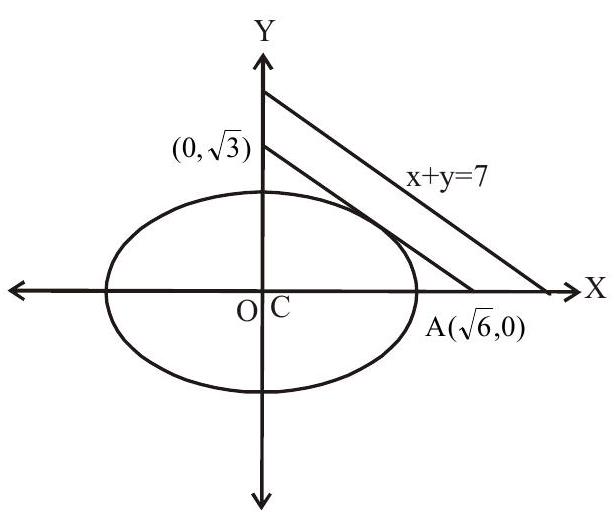
option (c) is correct
5. The length of the common chord of the ellipse $\dfrac{(x-1)^{2}}{9}+\dfrac{(y-2)^{2}}{4}=1$ and the circle $(\mathrm{x}-1)^{2}+(\mathrm{y}-2)^{2}=1$ is
(a) 0
(b) 1
(c) 3
(d) 8
Show Answer
Solution:
Centre of ellipse and circle is $(1,2)$.
Since the ellipse contains the circle and they do not intersect so there is no common chord
$\therefore$ length of common chord is zero
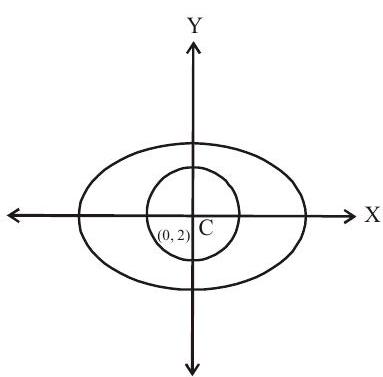
Option ‘a’ is correct
6. If the normal at the end of laturrectum of the ellipse $\dfrac{x^{2}}{a^{2}}+\dfrac{y^{2}}{b^{2}}=1$ passes through $(0,-b)$ then $\mathrm{e}^{4}+\mathrm{e}^{2}$ (where e is eccentricity) equals
(a) 1
(b) $\sqrt{2}$
(c) $\dfrac{\sqrt{5}-1}{2}$
(d) $\dfrac{\sqrt{5}+1}{2}$
Show Answer
Solution:
Equation of normal at the extremity of latus rectum in the first quadrant $\left(\mathrm{ae}, \dfrac{\mathrm{b}^{2}}{\mathrm{a}}\right)$ is
$\dfrac{a^{2} x}{a e}-\dfrac{b^{2} y}{b^{2} / a}=a^{2}-b^{2}$
$a x-a e y=a^{2} e-b^{2} e$ ________________(1)
$a x-a e y=a^{2} e-e\left(a^{2}-a^{2} e^{2}\right)$
$a x-a e y=a^{2} e-a^{2} e+a^{2} e^{3}$
$x-e y=a e^{3}$ ________________(2)
(1) passes through $(0,-\mathrm{b})$ then
$\mathrm{be}=\mathrm{ae}^{3}$
$\begin{aligned} & \mathrm{b}=\mathrm{ae}^{2} \\ & \text { squaring } \\ & \mathrm{b}^{2}=\mathrm{a}^{2} \mathrm{e}^{4} \\ & \mathrm{a}^{2}\left(1-\mathrm{e}^{2}\right)=\mathrm{a}^{2} \mathrm{e}^{4} \\ & 1-\mathrm{e}^{2}=\mathrm{e}^{4} \end{aligned}$
or
$\mathrm{e}^{4}+\mathrm{e}^{2}=1$
$\therefore$ correct option is (a)
7. The area of the parallelogram formed by the tangents at the end of conjugate diameters of an ellipse is
(a) Constant and is equal to the product of the axes
(b) Cannot be constant
(c) Constant and is equal to the two lines of the product of the axes.
(d) None of these
Show Answer
Solution:
Two diameters are said to be conjucgate when each bisects all chords parallel to the other.
Conjugate diameters are diameters passing through centre and product of their slopes is equal to $\dfrac{-b^{2}}{a^{2}}$ Area of parallelogram $=4$ area of parallelogram QDCE
$=4(2 \text { area of } \Delta \mathrm{CDE})$
$=8 \cdot \dfrac{1}{2}\left|\begin{array}{ccc}0 & 0 & 1 \\ \mathrm{a} \cos \alpha & \mathrm{b} \sin \alpha & 1 \\ -\mathrm{a} \sin \alpha & \mathrm{b} \cos \alpha & 1\end{array}\right|$
$=4\left(a b \cos ^{2} \alpha+a b \sin ^{2} \alpha\right)$
$=4 \mathrm{ab}$
$=(2 \mathrm{a}) \times(2 \mathrm{~b})$
$=$ Product of the axes of ellipse
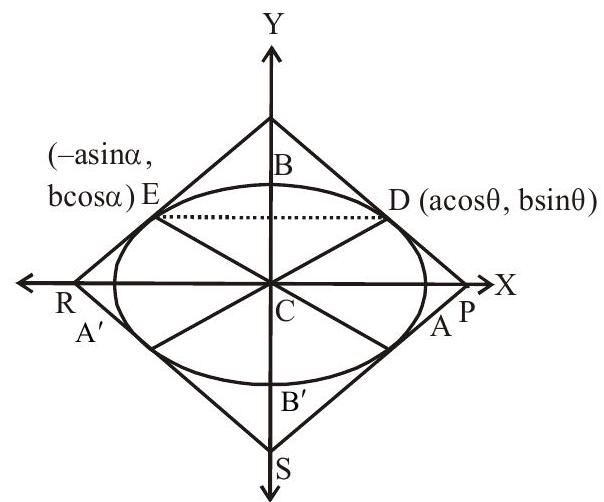
Option (a) is correct
Practice Exercise
1. The eccentricity of the ellipse which meets the straight line $\dfrac{x}{7}+\dfrac{y}{2}=1$ on the axis of $x$ and the straight line $\dfrac{x}{3}-\dfrac{y}{5}=1$ on the axis of $y$ and whose axes lie along the axes of coordinates, is
(a) $\dfrac{3 \sqrt{2}}{7}$
(b) $\dfrac{2 \sqrt{3}}{7}$
(c) $\dfrac{\sqrt{3}}{7}$
(d) None of these
Show Answer
Answer: d2. The parametric representation of point on the ellipse whose foci are $(-1,0)$ and $(7,0)$ and eccentricity is $\dfrac{1}{2}$, is
(a) $(3+8 \cos \theta, 4 \sqrt{3} \sin \theta)$
(b) $(8 \cos \theta, 4 \sqrt{3} \sin \theta)$
(c) $(3+4 \sqrt{3} \cos \theta, 8 \sin \theta)$
(d) None of these
Show Answer
Answer: a3. The locus of midpoints of a focal chord of the ellipse $\dfrac{x^{2}}{a^{2}}+\dfrac{y^{2}}{b^{2}}=1$ is
(a) $\dfrac{x^{2}}{a^{2}}+\dfrac{y^{2}}{b^{2}}=\dfrac{e x}{a}$
(b) $\dfrac{\mathrm{x}^{2}}{\mathrm{a}^{2}}-\dfrac{\mathrm{y}^{2}}{\mathrm{~b}^{2}}=\dfrac{\mathrm{ex}}{\mathrm{a}}$
(c) $\mathrm{x}^{2}+\mathrm{y}^{2}=\mathrm{a}^{2}+\mathrm{b}^{2}$
(d) None of these
Show Answer
Answer: a4. The eccentricity of an ellipse $\dfrac{x^{2}}{a^{2}}+\dfrac{y^{2}}{b^{2}}=1$ whose latus rectum is half of its minor axis is
(a) $\dfrac{1}{\sqrt{2}}$
(b) $\sqrt{\dfrac{2}{3}}$
(c) $\dfrac{\sqrt{3}}{2}$
(d) None of these
Show Answer
Answer: c5. If $\mathrm{P}(\theta)$ and $\mathrm{Q}\left(\dfrac{\pi}{2}+\theta\right)$ are two points on the ellipse $\dfrac{\mathrm{x}^{2}}{\mathrm{a}^{2}}+\dfrac{\mathrm{y}^{2}}{\mathrm{~b}^{2}}=1$, locus of the mid point of $\mathrm{PQ}$ is
(a) $\dfrac{\mathrm{x}^{2}}{\mathrm{a}^{2}}+\dfrac{\mathrm{y}^{2}}{\mathrm{~b}^{2}}=\dfrac{1}{2}$
(b) $\dfrac{\mathrm{x}^{2}}{\mathrm{a}^{2}}+\dfrac{\mathrm{y}^{2}}{\mathrm{~b}^{2}}=4$
(c) $\dfrac{\mathrm{x}^{2}}{\mathrm{a}^{2}}+\dfrac{\mathrm{y}^{2}}{\mathrm{~b}^{2}}=2$
(d) None of these
Show Answer
Answer: a6. If $\alpha$ and $\beta$ are eccentric angles of the ends of a focal chord of the ellipse $\dfrac{x^{2}}{a^{2}}+\dfrac{y^{2}}{b^{2}}=1$, then $\tan \dfrac{\alpha}{2} \tan \dfrac{\beta}{2}$ is equal to
(a) $\dfrac{1-\mathrm{e}}{1+\mathrm{e}}$
(b) $\dfrac{e-1}{e+1}$
(c) $\dfrac{\mathrm{e}+1}{\mathrm{e}-1}$
(d) $\dfrac{e-1}{e+3}$
Show Answer
Answer: b7. The locus of extremities of the latus-rectum of the family of ellipse $b^{2} x^{2}+y^{2}=a^{2} b^{2}$ is
(a) $x^{2}-a y=a^{2}$
(b) $x^{2}-a y=b^{2}$
(c) $\mathrm{x}^{2}+\mathrm{ay}=\mathrm{a}^{2}$
(d) $x^{2}+a y=b^{2}$
Show Answer
Answer: a, c8. The tangents from which of the following points to the ellipse $5 x^{2}+4 y^{2}=20$ are perpendicular
(a) $(1,2 \sqrt{2})$
(b) $(2 \sqrt{2}, 1)$
(c) $(2, \sqrt{5})$
(d) $(\sqrt{5}, 2)$
Show Answer
Answer: a, b, c, d9. An ellipse passes through the point (4,-1) and its axes are along the axes of coordinate. If the line $x+4 y-10=0$ is a tangent to it then its equation is
(a) $\dfrac{x^{2}}{100}+\dfrac{y^{2}}{5}=1$
(b) $\dfrac{\mathrm{x}^{2}}{80}+\dfrac{\mathrm{y}^{2}}{\dfrac{5}{4}}=1$
(c) $\dfrac{x^{2}}{20}+\dfrac{y^{2}}{5}=1$
(d) None of these
Show Answer
Answer: b, c10. Passage
Consider the standard equation of an ellipse whose focus and corresponding foot of directrix are $(\sqrt{7}, 0)$ and $\left(\dfrac{16}{\sqrt{7}}, 0\right)$ and a circle with equation $x^{2}+y^{2}=r^{2}$. If in the first quadrant, the common tangent to a circle of this family and the above ellipse meets the coordinate axes at A and B. On the basis of above information, answer the following questions.
(i) The equation of the ellipse is
(a) $16 x^{2}+9 y^{2}=144$
(b) $9 x^{2}+16 y^{2}=144$
(c) $16 \mathrm{x}^{2}+\mathrm{y}^{2}=144$
(d) $x^{2}+9 y^{2}=144$
(ii) Let $\mathrm{P}$ be a variable point on the ellipse with foci at $\mathrm{S}$ and $\mathrm{S}^{\prime}$. If $\Delta$ be the area of triangle $\mathrm{PSS}^{\prime}$, then the maximum value of $\Delta$ is
(a) $\sqrt{7}$ sq.u.
(b) $2 \sqrt{7}$ sq.u
(c) $3 \sqrt{7}$ sq.u
(d) $4 \sqrt{7}$ sq.u.
(iii) If mid-point of And B is $\left(\mathrm{x} _{1}, \mathrm{y} _{1}\right)$ and slope of common tangent be $\mathrm{m}$, then
(a) $2 \mathrm{mx} _{1}+\mathrm{y} _{1}=0$
(b) $2 \mathrm{my} _{1}+\mathrm{x} _{1}=0$
(c) $\mathrm{my} _{1}+\mathrm{x} _{1}=0$
(d) $\mathrm{mx} _{1}+\mathrm{y} _{1}=0$
(iv) The locus of midpoint of $A$ and $B$ is
(a) $y=x \sqrt{\dfrac{r^{2}-9}{16-r^{2}}}$
(b) $y=x \sqrt{\dfrac{16+r^{2}}{9-r^{2}}}$
(c) $y=x \sqrt{\dfrac{16-r^{2}}{r^{2}+9}}$
(d) $y=x \sqrt{\dfrac{r^{2}-9}{r^{2}-16}}$
(v) The domain of value of $\mathrm{r}(\mathrm{r}>0)$ for which the above question is true is
(a) $\mathrm{r} _{\in}(1,2)$
(b) $r \in(3,4)$
(c) $\mathrm{r} _{\in}(4,5)$
(d) $\mathrm{r} _{\in}(5,6)$
Show Answer
Answer: (i) b (ii) c (iii) d (iv) a (v) b11. Assertion and Reason
(A) Both $\mathrm{A}$ and $\mathrm{R}$ are individually true and $\mathrm{R}$ is the correct explanation of $\mathrm{A}$
(B) Both $\mathrm{A}$ and $\mathrm{R}$ are individually true and $\mathrm{R}$ is not the correct explanation of $\mathrm{A}$
(C) $A$ is true but $R$ is false
(D) A is false but $R$ is true
(i) Assertion (A)
Any chord if the ellipse $x^{2}+y^{2}+x y=1$ through $(0,0)$ is bisected at $(0,0)$
Reason (R)
The centre of an ellipse is a point through which every chord is bisected
(a) $\mathrm{A}$
(b) $\mathrm{B}$
(c) $\mathrm{C}$
(d) $\mathrm{D}$
(ii) Assertion A
From the point $(\lambda, 3)$ tangents are drawn to $\dfrac{x^{2}}{9}+\dfrac{y^{2}}{4}=1$ and are perpendicular to each other then $\lambda= \pm 2$
Reason $R$ The locus of point of intersection of perpendicular tangents to $\dfrac{x^{2}}{9}+\dfrac{y^{2}}{4}=1$ is $x^{2}+3 y=13$
(a) $\mathrm{A}$
(b) B
(c) $\mathrm{C}$
(d) $\mathrm{D}$
(iii) Assertion A The equation of the director cirlce to the ellipse $9 x^{2}+16 y^{2}=144$ is $x^{2}+y^{2}=25$
Reason R Director circle is the locus of point of intersection of perpendicular tangents to an ellipse
(a) $\mathrm{A}$
(b) $\mathrm{B}$
(c) $\mathrm{C}$
(d) $\mathrm{D}$
Integer Type
Show Answer
Answer: (i) a (ii) c (iii) a12. If e be the eccentricity of the ellipse $4(x-2 y+1)^{2}+9(2 x+y+2)^{2}=25$, then the value of $2187 e^{2}$ must be
Show Answer
Answer: (1215)13. If two concentric ellipse be such that the foci of one be on the other and if $3 / 5$ and $4 / 5$ be their eccentricities. If $\theta$ be the angle between their axes, then the volue of $1+\sin \theta+\sin ^{4} \theta$ must be.
Show Answer
Answer: (0003)14. If the normal at the four points $\left(\mathrm{x} _{1}, \mathrm{y} _{1}\right),\left(\mathrm{x} _{2}, \mathrm{y} _{2}\right),\left(\mathrm{x} _{3}, \mathrm{y} _{3}\right)$ and $\left(\mathrm{x} _{4}, \mathrm{y} _{4}\right)$ on the ellipse $\dfrac{\mathrm{x}^{2}}{\mathrm{a}^{2}}+\dfrac{\mathrm{y}^{2}}{\mathrm{~b}^{2}}=1$ are concurrent, then the value of $\left(\mathrm{x} _{1}+\mathrm{x} _{2}+\mathrm{x} _{3}+\mathrm{x} _{4}\right)\left(\dfrac{1}{\mathrm{x} _{1}}+\dfrac{1}{\mathrm{x} _{2}}+\dfrac{1}{\mathrm{x} _{3}}+\dfrac{1}{\mathrm{x} _{4}}\right)$ must be
Show Answer
Answer: (0004)15. Tangents are drawn to the ellipse $\dfrac{x^{2}}{9}+\dfrac{y^{2}}{5}=1$ at ends of latusrectum. If the area of quadrilateral be $\lambda$ sq.u, then the value of $\lambda$ must be










